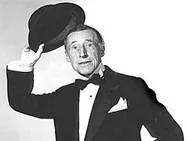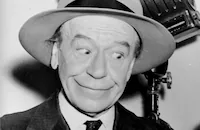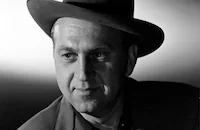Keeper of the Flame

Brief Synopsis
Cast & Crew
George Cukor
Spencer Tracy
Katharine Hepburn
Richard Whorf
Margaret Wycherly
Forrest Tucker
Film Details
Technical Specs

Synopsis
When venerated World War I hero Robert Forrest dies in an automobile accident, the nation mourns his loss and the press congregates outside the gates of his estate in pursuit of a story. Just returned from Berlin, esteemed war correspondent Steven O'Malley joins his peers Freddie Ridges and Jane Harding, but remains aloof from the pack. As Freddie questions the police report of Forrest's death, Steven maintains that he wants to write the story of Forrest's life as an inspiration for the "dark days ahead." To placate the journalists, Forrest's private secretary, Clive Kerndon, holds a press conference. Determined to win an interview with Forrest's widow Christine, Steven takes a taxi to the estate but is turned away by the gatekeeper, Jason Rickards, an embittered man who cryptically states that he was Forrest's top sergeant until a war wound relegated him to gatekeeper. As Steven walks away, he notices a sobbing little boy, Jason's son Jeb, who blames himself for his idol Forrest's death because he failed to warn him about the precarious state of the bridge that collapsed under the weight of Forrest's car, sending him crashing to his death in the river below. After Steven consoles Jeb and explains his mission, the boy agrees to lead him along a secret path to the Forrest house. There, Steven watches as Christine reverently arranges a bouquet of flowers in front of her late husband's portrait. After Christine refuses to help Steven write his "memorial to her late husband's memory," Kerndon privately rebukes her and warns her to cooperate lest Steven become suspicious of her behavior. As Steven drives back to the hotel, his talkative cab driver, Orion Peabody, gossips about the animosity that existed between Forrest and Christine's cousin, Geoffrey Midford. Soon after Steven retires to his room, Christine appears at the hotel and offers to help him write her husband's story, and they arrange to meet the following day at her house. From his hotel room window, Steven watches as Christine drives away with Geoffrey. On the taxi ride to the Forrest estate the next day, Orion chats away about Christine paying the overdue mortgage on Geoffrey's farm. Distracted, Orion runs into Dr. Fielding's car and Steven learns that the doctor has come to the gatehouse to treat Jeb, who has fallen ill with a fever. As the ailing boy tells Steve about his sister Janet, who worked as Forrest's secretary until she abruptly went away, Jason enters the room and interrupts their conversation. Picking up the gatehouse phone, Steven calls the big house but is instead connected to Forrest's elderly mother. When Jason forbids Steven to use the phone, Steven begins to suspect that he is hiding something. Upon returning to his hotel, Steven finds a group of children from Forward America, the youth group founded by Forrest, waiting there with a deep sense of loss because Christine has refused to see them. The next day, Steven returns to the Forrest house and is surprised that Christine has left on a mysterious trip with Geoffrey. When Steven questions Kerndon about Forrest's mother, Kerndon discourages him from approaching her. Later, Steven asks the doctor about Jeb's sister and he replies that the girl was sent to a sanitarium after suffering a nervous breakdown. After returning from her trip, Christine visits Jeb at the gatehouse and Steven finds her there. On the drive back to the big house, Steven asks Christine about a windowless stone building on the property and she responds that is the arsenal, the place that her husband went to collect his thoughts. As Steven studies Forrest's papers at the house, Kerndon berates Christine for failing to give him the keys to the arsenal in her absence. Afterward, Christine runs out to the stone building, piles papers from her husband's desk into the fireplace and sets them on fire. Questioned by Steven about the stone building, Kerndon lies that it is a storehouse. When Steven leaves the house for a stroll, the panicky Kerndon calls New York to reassure his superior that he will "take care" of the arsenal. After meeting Christine at the door to the arsenal, Steven proceeds with her to the stable, where her horse is being treated for an leg injury he suffered on the day of Forrest's accident. Steven is skeptical when Christine explains that her horse's mishap prevented her from riding to the bridge and discovering that it had collapsed. As the two mount up for a ride, Steven confides that he thinks the bridge was sabotaged and implores Christine to trust him. They then ride to Forrest's mother's house where the demented woman raves on about her son's murder and accuses Christine of deliberately failing to warn Forrest about the condition of the bridge. Frustrated, Steven announces that he is abandoning the story and rides back to the house alone. Along the trail, he spots Freddie sketching the broken bridge and finds a discarded horse shoe near the river bank. When Steve discovers that the shoe matches Christine's injured horse's hoof, he realizes that she must have ridden to the bridge. That night, as Kerndon demands that Christine hand over the keys to the arsenal's filing cabinet, Steven knocks at the door, shows her the horse shoe and charges her with her husband's death. After accusing her of complicity with Geoffrey, Steven departs and Christine hurries to destroy the evidence locked within the arsenal. As Steven prepares to leave the estate, he encounters Geoffrey, who introduces him to Janet and announces their engagement. Jason then explains that Geoffrey and Janet had been childhood sweethearts. Janet, suffering from hero worship of Forrest, suffered a nervous breakdown and was institutionalized by Christine and Geoffrey, who had spent the last few days visiting her and arranging for her discharge. Realizing that he has wrongly accused Christine, Steven proceeds to the arsenal, declares his love to Christine and offers his support. Despondent, Christine recounts that the masses' worship of her husband transformed him into an arrogant, power hungry monster intent on smashing democracy. Unlocking the filing cabinet, Christine displays papers documenting Forrest's diabolical scheme to turn Americans against one another, thus weakening the country and enabling the institution of a fascistic form of government. Aware that Forrest was on his way to meet his fellow saboteurs, Christine decided not to warn him that the bridge was out, thus insuring his death. After Christine agrees to help Steven tell her husband's true story, Steven notices smoke pouring into the building and realizes that Kerndon has started a fire. Kerndon then shoots Christine, who dies in Steven's arms, begging him to expose Forrest. After locking Steven inside the burning building, Kerndon runs onto the road and fires at on oncoming car carrying Freddie and Jane. After their vehicle collides with Kerndon, Freddie and Jane rush to the arsenal, break down the door and rescue Steven, who then writes an expose about Forrest and a loving tribute to Christine.

Director

George Cukor
Cast

Spencer Tracy

Katharine Hepburn

Richard Whorf

Margaret Wycherly

Forrest Tucker

Frank Craven

Horace Mcnally

Percy Kilbride

Audrey Christie

Darryl Hickman

Donald Meek

Howard Da Silva
William Newell
Mary Mcleod
Clifford Brooke
Rex Evans
Blanche Yurka
Craufurd Kent
Mickey Martin
Manart Kippen
Don Gallaher
Cliff Danielson
Jay Ward
Rita Quigley
Dick Elliott

Edward Mcwade
Irvin Lee
Diana Dill
Gloria Tucker
Dr. Charles Frederick Lindsley
Robert Pittard
Louis Mason
Sam Harris
Art Howard
Harold Miller
Crew
Adrian
Cedric Gibbons
Leon Gordon
Bronislau Kaper
Jack Moore
James E. Newcom
Warren Newcombe
Bill Ryan
Victor Saville
Douglas Shearer
Donald Ogden Stewart
Lyle Wheeler
Edwin B. Willis
Edward Woehler

Photo Collections
Videos
Movie Clip





Trailer
Film Details
Technical Specs

Articles
Keeper of the Flame
During production of the film, as Barbara Leaming wrote in her book Katharine Hepburn, Hepburn doted on Tracy to everyone's bewilderment, "The sight of Tracy and Hepburn at close range made people uneasy. On the set of Keeper of the Flame, they appeared to exist in a world of their own. To watch them together was to wonder why this fierce, independent woman had so totally subordinated herself to Tracy's will. She fussed over him incessantly, as if unable to keep still. She combed his hair. She arranged his collar. She wiped his face. She massaged his temples. She made certain he was comfortable and had everything he needed. No detail escaped Kate's attention so long as it concerned Spencer's well-being. There was seemingly no limit to her devotion. She closely monitored every fluctuation of his chronic melancholy. She was producer, director, wardrobe mistress and makeup lady all rolled into one. She was warm, effusive, and loving. There could be no doubt that she worshipped him...Tracy, for his part, appeared to take Kate for granted. At times, he barely responded to her powerful presence. He showed no gratitude or affection. When he did take notice of her, he treated her as a sort of 'backward little girl'. She reacted to his abuse with a tight, tense smile that was enough to break one's heart."
Tracy was a married Catholic and his wife was prominent in the Los Angeles area because of the John Tracy Clinic the couple had set up to help deaf children like their son for whom the clinic was named. Tracy would not divorce her and out of respect for Louise, both Hepburn and Tracy made a point of keeping their relationship as private as possible. The press even left them alone, something which is almost incomprehensible in an era where the media pokes its cameras into every aspect of a celebrity's personal life. Hepburn never discussed their personal relationship publicly until after Louise Tracy's death, but it was an open secret in Hollywood.
As for Keeper of the Flame, there were problems from the start, especially concerning Donald Ogden Stewart's script. Patrick McGilligan wrote in his biography of the film's director, George Cukor, George Cukor: A Double Life, that "Stewart fought to adapt I.A.R. (I for Ida) Wylie's novel, which had been purchased in unpublished form by MGM, as a kind of testament to Stewart's own sincere political convictions. The novel was willfully oblique, but Stewart shaped his film script into a pointed political drama, underplaying the love story. However, there was resistance to Stewart's uncharacteristically meaningful script from, of all people, Katharine Hepburn. She wanted more romance, and to return to the sense of the book, where the male character was an 'impotent eunuch," according to Stewart, "who plays sad love scenes."
Stewart wrote to his wife, the journalist Ella Winter, to complain that Hepburn was undercutting his script. "I created an intelligent male with action as his keystone...Is it not interesting that Miss H., not being an active character in the story, is Goddamned if there will be an active male in the same story?" Hepburn took her fight to the studio heads. "Stewart felt that Hepburn's stand was not really about the script ('it is for control'), he felt she had betrayed him 'dirtily' by appealing to her 'real enemies', 'The Top Bosses'."
Stewart also felt betrayed by Cukor for not standing up for his script, which Cukor admitted harmed the film. As Anne Edwards wrote, "Cukor later commented, 'The story was basically fraudulent,' and Kate 'had to float in wearing a long white gown and carrying a bunch of lilies. That's awfully tricky isn't it? And doesn't she give long, piercing looks at his [her husband's] portrait over the mantel? Well, I think she finally carried a slightly phony part because her humanity asserted itself and her humor. They always did."
Script problems aside, there was no denying the Hepburn-Tracy chemistry in Keeper of the Flame, and reviewers took note. "[T]he two principal players, Mr. Tracy and Miss Hepburn, give Keeper of the Flame its full values, goes without saying. They are a beautifully matched team as witness Woman of the Year [1942], and they bring to the current business their finest efforts " ( The New York Morning-Telegraph March 19, 1943), with special praise given to Tracy's "restrained convincing characterization that holds the discursive script together." ( Newsweek , March 22, 1943)
Producer: Leon Gordon, Victor Saville
Director: George Cukor
Screenplay: Donald Ogden Stewart, I.A.R. Wylie (novel)
Cinematography: William Daniels
Film Editing: James E. Newcom
Art Direction: Cedric Gibbons
Music: Bronislau Kaper
Cast: Spencer Tracy (Steve O'Malley), Katharine Hepburn (Christine Forrest), Richard Whorf (Clive Kerndon), Margaret Wycherly (Old Mrs. Forrest), Forrest Tucker (Geoffrey Midford), Frank Craven (Doctor Fielding).
BW-100m. Closed captioning.
by Lorraine LoBianco
SOURCES:
Katharine Hepburn by Barbara Leaming
Spencer Tracy: A Bio-Bibliography by James Fisher
A Remarkable Woman: A Biography of Katharine Hepburn by Anne Edwards
Spencer Tracy: Tragic Idol by Bill Davidson
George Cukor: A Double Life: A Biography of the Gentleman Director by Patrick McGilligan

Keeper of the Flame
Quotes
Trivia
Notes
According to a December 1941 Hollywood Reporter news item, M-G-M bought the rights to the I. A. R. Wylie novel from RKO for $50,000. RKO had bought the property when it was an "embryonic idea," but later decided that it would need too many changes to film and presented too many casting difficulties due to the lack of suitable stars at RKO. Although Hollywood Reporter news items add Dorothy Morris, Jay Yard and Barry Bernard to the cast and state that Glenn Anders was testing for a role, their appearance in the released film has not been confirmed. A July 22, 1942 news item notes that Pauline Lord was in the cast, but in a modern interview, director George Cukor stated that Lord was originally cast as "Mrs. Forrest." According to Cukor, the scene with Lord was shot, but didnt work, and so she was replaced by Margaret Wycherly. This picture marked the screen debut of Audrey Christie and Mary McLeon. According to a June 1942 Hollywood Reporter news item, Hepburn suggested that Christie be tested for the role of "Jane Harding." Previous to her appearance in this film, McLeod was an unknown Canadian school teacher, according to a December 1942 Hollywood Reporter news item.
Keeper of the Flame was the last picture made by costume designer Adrian before leaving M-G-M. He had been head of the costume departmart for many years and was credited as being largely responsible for the M-G-M "look" popular throughout the 1930s. Adrian worked at various other studios throughout the 1940s and opened his own fashion house. He returned to M-G-M as costume designed for Lovely to Look At (see AFI Catalog of Feature Films, 1951-60).
According to an October 1943 New York Times news item, several Republican legislators complained to the Production Code Administration that this picture was propagandistic. In a modern interview, Cukor stated that the picture was made "during a period of undercover Fascism in the country. Certain things were in the air but hadnt come out into the open I suppose, to draw attention to them, we exaggerated." The New York Times review commented that this film "touches frankly upon a phase of American life that is most serious and pertinent today."

Miscellaneous Notes
Released in United States 1942
Released in United States 1942














